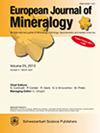Ca-Mg碳酸盐熔炼关系及9 GPa以下碳酸盐熔炼微量元素特征——碳酸化地幔岩性熔炼的表征
IF 1.7
3区 地球科学
Q2 MINERALOGY
引用次数: 0
摘要
摘要地球上地幔中存在Ca–Mg碳酸盐(CaCO3–MgCO3)最深远的后果可能是降低地幔的熔融温度并控制熔体成分。含碳酸盐地幔的低温部分熔融产生富含二氧化碳、贫二氧化硅的熔体,这是由碳酸盐的熔融关系造成的。因此,了解CaCO3–MgCO3系统中的熔融关系有助于解释天然含碳酸盐硅酸盐系统。我们报道了CaCO3–MgCO3体系的熔融关系,以及碳酸盐和碳酸盐矿之间微量元素的分配系数 GPa)和温度(1300–1800 ∘C) 使用摇摆式多砧压力机。在没有水的情况下,Ca–Mg碳酸盐沿着俯冲板块典型的地热辐射是稳定的。Ca–Mg碳酸盐(~ Mg0.1–0.9Ca0.9–0.1CO3)部分融化在大洋中脊和羽流环境中。Ca–Mg碳酸盐不协调地熔融,形成方镁石晶体,碳酸盐在4和9之间熔融 GPa。此外,我们发现I组金伯利岩的稀土元素(REE)特征,即相对于原始地幔的强REE分馏和重REE的贫化,与6和9时与含Ca菱镁矿和方镁石平衡的碳酸盐化作用相似 GPa。这表明,CaCO3–MgCO3系统的白云石-菱镁矿结合可能有助于近似金伯利岩母体富含碳酸盐的熔体的REE特征。本文章由计算机程序翻译,如有差异,请以英文原文为准。
Melting relations of Ca–Mg carbonates and trace element signature of carbonate melts up to 9 GPa – a proxy for melting of carbonated mantle lithologies
Abstract. The most profound consequences of the presence of Ca–Mg carbonates (CaCO3–MgCO3) in the Earth's upper mantle may be to lower the melting temperatures of the mantle and control the melt composition. Low-degree partial melting of a carbonate-bearing mantle produces CO2-rich, silica-poor melts compositionally imposed by the melting relations of carbonates. Thus, understanding the melting relations in the CaCO3–MgCO3 system facilitates the interpretation of natural carbonate-bearing silicate systems. We report the melting relations of the CaCO3–MgCO3 system and the partition coefficient of trace elements between carbonates and carbonate melt from experiments at high pressure (6 and 9 GPa) and temperature (1300–1800 ∘C) using a rocking multi-anvil press. In the absence of water, Ca–Mg carbonates are stable along geothermal gradients typical of subducting slabs. Ca–Mg carbonates (∼ Mg0.1–0.9Ca0.9–0.1CO3) partially melt beneath mid-ocean ridges and in plume settings. Ca–Mg carbonates melt incongruently, forming periclase crystals and carbonate melt between 4 and 9 GPa. Furthermore, we show that the rare earth element (REE) signature of Group-I kimberlites, namely strong REE fractionation and depletion of heavy REE relative to the primitive mantle, is resembled by carbonate melt in equilibrium with Ca-bearing magnesite and periclase at 6 and 9 GPa. This suggests that the dolomite–magnesite join of the CaCO3–MgCO3 system might be useful to approximate the REE signature of carbonate-rich melts parental to kimberlites.
求助全文
通过发布文献求助,成功后即可免费获取论文全文。
去求助
来源期刊
CiteScore
2.80
自引率
9.50%
发文量
40
审稿时长
6-12 weeks
期刊介绍:
EJM was founded to reach a large audience on an international scale and also for achieving closer cooperation of European countries in the publication of scientific results. The founding societies have set themselves the task of publishing a journal of the highest standard open to all scientists performing mineralogical research in the widest sense of the term, all over the world. Contributions will therefore be published primarily in English.
EJM publishes original papers, review articles and letters dealing with the mineralogical sciences s.l., primarily mineralogy, petrology, geochemistry, crystallography and ore deposits, but also biomineralogy, environmental, applied and technical mineralogy. Nevertheless, papers in any related field, including cultural heritage, will be considered.

 求助内容:
求助内容: 应助结果提醒方式:
应助结果提醒方式:


